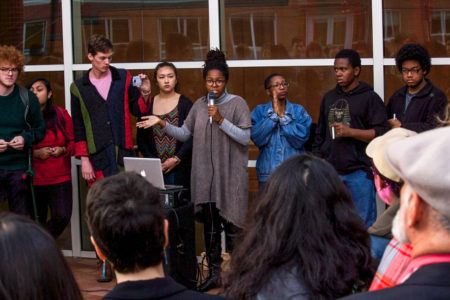
By Steve Yang
yangstev17@grinnell.edu
If you’re walking alongside the glass panes in the JRC that face 8th Ave., you would see a list of names in red lettering, each representing a person of color who has been killed in incidents with police forces around the United States. The list is meant to be jarring for anyone. But for Morgane Garnier ’19, Simonne Carlton ’18 and Hazel Batrezchavez ’17, the Occupy 8th organizers who placed the names, the names are a “symbolic and artistic representation … of the misuse and abuse of power.”
After meeting through their mutual desire to create a space for remembering these lives, the trio combined their plans for individual events into a symposium throughout the week. Beginning with a vigil and rally held in front of the JRC on Monday, Oct. 31, the list of events included a dialogue covering the goals for visibility at the Campus Council meeting on Wednesday and a panel discussion on Thursday evening in JRC 101. At each event, the organizers said that they were impressed by the turnout and wanted to use the momentum they had gathered to keep pushing for spaces of healing.
“The vigil was our starting event of the week, and that’s not where it ends. Those events are important, but it’s an introduction,” Batrezchavez said.
Garnier agreed that it is common to have just a single discussion and fail to follow up, a problem which has greatly frustrated her at Grinnell.
“You mourn, but then there’s action, and there’s reform. When you experience loss, there’s mourning, but you want to take that sadness and that anger towards demonstration and action,” she said.
Seeking to combine dialogue with other mediums, the group used a projector at the rally on Wednesday evening to broadcast a series of videos with raw footage depicting incidents between police and people of color. Different speakers in a circle of approximately 60-70 people were given a chance to talk about fighting against police brutality, and allies were called upon to address what was discussed as a society-wide grievance.
“The destruction of black and brown bodies is an insult to all of us,” said one speaker, who identifies as Asian. “People in power have used us as a false model minority, as a stick to put down other racial groups. It doesn’t matter who it is, it doesn’t matter to them which of us they kill.”
Members of the rally were encouraged to detach stereotypes of race, to refuse to keep standing on the sidelines, and to link arms while calling out harmful associations that they had heard in the media or in their daily lives pertaining to race and racism. The group chanted “Black Lives Matter” and sang hymns of other activist movements, such as “Malcolm X was a freedom fighter and he taught us how to fight …” drawing the attention of students wandering nearby.
But that was not enough to draw in the students whom the Occupy 8th organizers see as friends and classmates, and whom they felt turned their backs on a movement that the organizers say cannot be ignored. Carlton noted that many people were walking by pretending to be on their phones, which she identified as a lack of community response.
“It’s a position of privilege to be able to ignore these violent and ridiculous acts. You can’t ignore it,” Carlton said. “You can’t just hide the posts like on Facebook. It’s not something that can be dismissed.”
Batrezchavez added that she felt many students who were privileged in being able to ignore these protests were not supporting the lived experiences of those around them, such as their classmates and professors.
“Your professors of color are being forced to sit in their car after being pulled over. You’re running through these spaces constantly every day, and people around you are being silenced,” she said.
The organizers wanted to emphasize that these events are organized by women of color, whose history in organizing social movements like the Black Lives Matter campaign or the civil rights movement have historically been left out.
“This was all organized by women, women of color. I noticed that in history, the strength of women of color in organizing these types of social protests or demonstrations is just erased,” Carlton said. “There’s so many examples, like the Black Lives Matter movement, which was founded by a group of queer black women … I really want people to realize that women of color are organizing this, and it can’t be denied.”
The conversation continued at the campus council meeting on Wednesday evening, when other allies spoke out on the need for recognition of these issues within SGA and keeping the community active in a manner conducive to social justice.
“At the end of our demonstration, someone from [President Kington’s] office offered to buy us pizza. I was kind of like, your presence here is more important than the pizza,” Batrezchavez said. “For bringing attention and people of color together, there should be no excuse. We know it was a nice gesture, but we hope that in the future, he does show up and decides to be a part of this.”
The organized events concluded with a panel discussion in JRC 101 on Thursday evening, which showcased five student speakers discussing their experiences concerning policing in a broader international scope. Garnier added that the panel was meant to invoke the feminist trope that “the personal is political.” Organizers also hoped the event would utilize a wide community of international and domestic students “to have the experience of thinking about how they’ve been targeted, and how that reveals larger issues with our country and around the world,” as Garnier explained.
In the future, Garnier, Carlton and Batrezchavez said that they hope more people will show up to these events, and that the Grinnell College community will address issues as an entire school.
“You can make time for it. There’s a reason we chose these times. I get the busy schedule, but if you don’t take the time, you can make the time,” Garnier said. “The decision not to make the time reveals a lot.”

























































